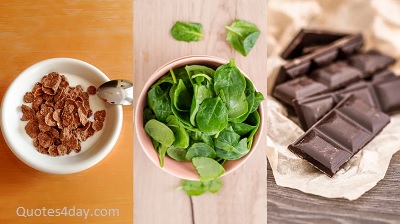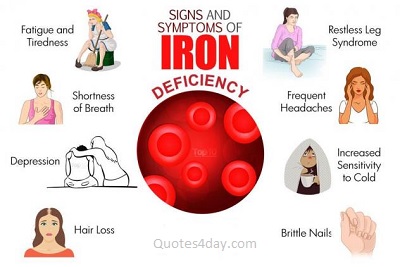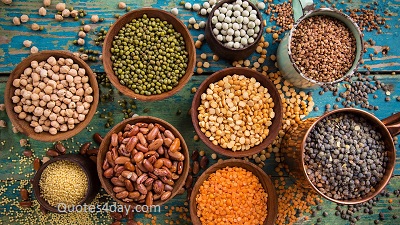If you are asked, what food contains a lot of iron? With a high degree of probability, you will answer that in apples. I hasten to upset you. The concentration of the trace element in this fruit is extremely low and is in the range of 0.02 mg – 0.1 mg per 100 g of the product (depending on the variety). Saturating the body with iron with the help of apples is tantamount to trying to quench your thirst by looking at the water. But do not be upset, in addition to apples, there are many iron-containing foods, which we will talk about. But first, a little introduction.

Low iron levels in the body are a common problem that is estimated to affect two billion people worldwide. The lack of a mineral does not have the best effect on human health and can even cause iron deficiency anemia. Fatigue appears, there is a lack of energy, the skin becomes pale, and hair falls out – and these are not all the symptoms that you will have to face.
Functions of Iron in the Body
Iron is a biologically important mineral that performs a number of functions in the body:
- Takes part in the formation of energy;
- Reduces the feeling of fatigue;
- Supports cognitive functions;
- Strengthens the immune system;
- Transports oxygen throughout the body;
- Takes part in the formation of red blood cells and hemoglobin;
- Supports the process of cell division.
How much iron should you get per day from food? The dosage largely depends on gender and age, on average it is 18 mg per day.
Who is at risk of iron deficiency anemia?
Low iron levels are fairly common and are overwhelmingly common in some groups of people. But this does not mean that this condition should not be paid attention to. On the contrary, it is important to control the level of the mineral in the blood in order to avoid more serious health problems. So, the following symptoms can signal an iron deficiency:
- Fast fatiguability;
- Erratic breathing;
- Tachycardia;
- Frequent headaches;
- Difficulty concentrating;
- Hair loss;
- Exacerbation of chronic diseases;
- Fluctuations in body temperature, frequent feelings of cold;
- Pale skin;
- Ulcers (seizures) in the corners of the mouth, etc.
If you notice similar symptoms in yourself, do not rush to run to the pharmacy. First, consult a doctor and take tests to understand what level of iron you have in your blood at the moment and whether you need any treatment.
Symptoms of iron deficiency anemia
There are people who need to monitor their iron levels in the blood and these include:
- Pregnant and lactating women;
- Infants and young children;
- Women with profuse menstruation ;
- Blood donors;
- People with certain diseases (oncology, gastrointestinal disorders);
- People who take drugs that prevent the absorption of iron;
- Vegans and vegetarians;
- Athletes.

To avoid deficiency states, it is enough to have foods rich in iron in the diet. After all, what could be better than a healthy and balanced diet?
Top 10 iron-rich foods
Here we got to the most interesting. Below are the foods that you should pay special attention to and include them in your diet.
Sesame
The leader in iron content, without any doubt, is sesame. 100 g of small seeds can contain about 16 mg of this trace element. This is 89% of the daily value. So don’t forget to regularly add sesame seeds to side dishes, salads, smoothies, yogurt, and other dishes. It is also a valuable source of fiber, plant protein, antioxidants, B vitamins, and more.
Sea kale
Not giving way to sesame, seaweed (kelp) also occupies a leading position in terms of iron content – 16 mg per 100 g of fresh product. Let’s not hide the fact that not everyone loves seaweed. But if you are a fan of such delicacies, make salads more often.
Cocoa
You would never think that cocoa can contain a large amount of iron. But it really is. 100 g of cocoa powder contains 13.9 mg of the mineral. This is 77% of the daily requirement of the body. Impressive, isn’t it? You are unlikely to be able to immediately overcome a hundred-gram serving of cocoa in order to replenish the body with a valuable trace element. But eating a piece of dark chocolate is another matter. By the way, 100 g of chocolate contains 3.4 mg of iron. But do not overdo it with a treat, because everything is useful in moderation.
Legumes
There is where to roam. We will not torment the reasoning for a long time, we suggest that you immediately go to the list with representatives of the plant source of iron:
- Lentils – 11.8 mg (65% of the daily value);
- Soy – 9.7 mg (53% of the daily value);
- Peas – 7 mg (38% of the daily value);
- Beans – 5.9 mg (32% of the daily value).

All data were taken per 100 g of product.
Wheat bran
Surely you have heard more than once about the benefits of bran for the body. They improve the functioning of the digestive tract, improve hormonal levels, improve skin condition, remove toxins, and supply the body with fiber and valuable nutrients. There was no iron. According to various sources, 100 g of processed wheat contains from 10.6 to 14 mg of this trace element.
Oysters
Something rich, you say. But to bypass and not talk about oysters would be dishonest. Undoubtedly, this is an amateur delicacy, but if you are one, you are not afraid of iron deficiency. 100 g of oysters contain as much as 7 mg of iron – 38% of the daily intake. Take note of this information.
Liver and offal
Some of the best-known sources of iron are organ meats: the liver, kidneys, and heart. As it turned out, they are not only tasty but also very useful. Let’s look at the numbers:
- 100 g of beef liver contains 6.9 mg of iron (38% of the daily requirement);
- 100 g of beef kidneys contain 6 mg of iron (33% of the daily requirement);
- 100 g of beef heart contains 4.8 mg of iron (26% of the daily requirement).
Some researchers have suggested that micronutrient deficiencies are less common in people who regularly eat meat. In fact, red meat is indeed the main source of heme iron (found only in meat, poultry, fish, and shellfish), which is so necessary for people prone to anemia.
Related Top 10 Foods High in Zinc: Benefits and Sources
Pine nut
We continue our list of products. And a pine nut successfully bursts into it. You can talk a lot about its benefits for a long time, but we are only interested in the amount of iron that it contains. So, 100 g of this nutritious nut contains 5.5 mg of iron. In turn, this is 30.5% of the daily intake. But note that it is recommended to eat no more than 30 g of peeled nucleoli per day, as they are quite nutritious.
Tofu
Tofu or bean curd will be a real discovery for people with special nutritional needs (vegans and vegetarians). It contains a lot of useful nutrients for the body. Iron in 100 g of bean curd is as much as 5.4 mg – 30% of the daily requirement. Treat yourself to cheese, and get not only pleasure but also health benefits.
Red meat
And here is the last contender for a place on your menu. Red meat satisfies hunger well and saturates the body with essential nutrients, including iron. 100 g of ground beef contains 2.7 mg of this mineral. And this is 15% of the daily intake.
On this, perhaps, we will end. But what about vegetables and fruits, you will be indignant. These foods were not included in this rating, since their iron content is low. Or have we forgotten something? Write in the comments what other foods in your opinion are rich in iron and should be included in the diet.
FAQs
1. Why is iron important for the body?
Iron is an essential mineral that is required for the production of hemoglobin, a protein in red blood cells that carries oxygen throughout the body. Iron is also necessary for proper immune function and for the synthesis of some hormones.
2. What are the best food sources of iron?
Some of the best food sources of iron include red meat, poultry, fish, beans, lentils, tofu, spinach, fortified breakfast cereals, and dried fruit.
3. Are there any foods that can inhibit the absorption of iron?
Yes, there are certain foods that can inhibit the absorption of iron, such as tea, coffee, and calcium-rich foods like milk and cheese.
4. How can vegetarians and vegans get enough iron in their diets?
Vegetarians and vegans can get enough iron in their diets by consuming iron-rich plant foods, such as beans, lentils, tofu, fortified cereals, spinach, and dried fruit. They can also increase their absorption of iron by consuming vitamin C-rich foods, such as citrus fruits, tomatoes, and bell peppers, at the same time as their iron-rich meals.
5. How much iron do I need per day?
The recommended daily intake of iron varies based on age, gender, and other factors. Generally, adult men need 8 mg of iron per day, while adult women who are premenopausal need 18 mg per day. Pregnant women need even more, typically around 27 mg per day.


